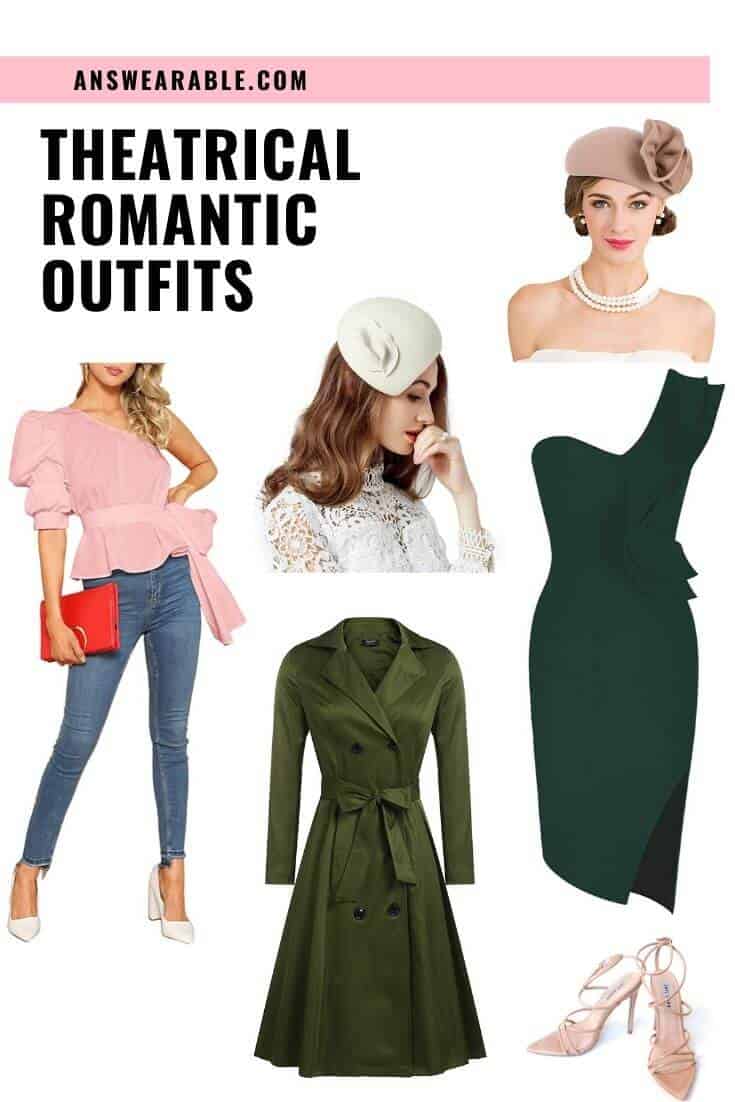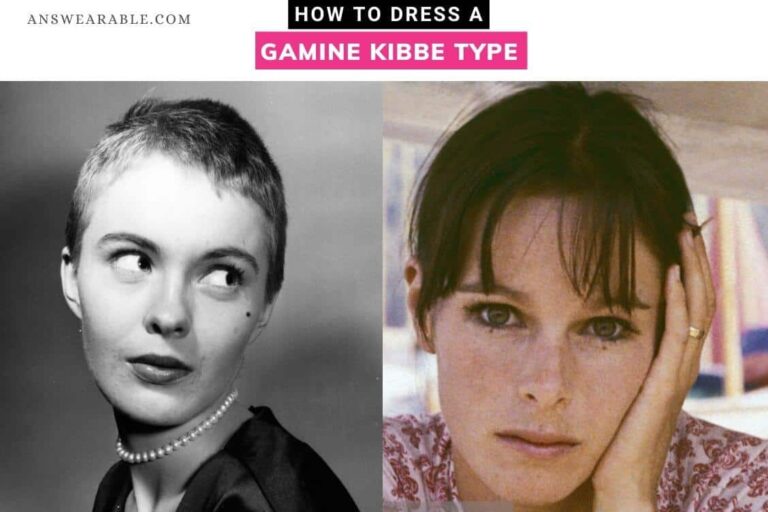As an affiliate, Answearable earns from qualifying purchases at NO cost to you. Learn More.
This article is a Theatrical Romantic shopping guide for both casual and formal outfits. Please note that these are only examples. While this will give you ideas and inspirations, know that these are not rules only ways to wear your outfits. You don’t have to follow these to a T. Just because you’re a Theatrical Romantic does not mean you should look like a replica of other Theatrical Romantics.
Your ultimate goal, as the wearer, is to express your own taste and marry it to the styling principles of a Theatrical Romantic. By mixing your own taste to it, you don’t end up looking like a replica of other Theatrical Romantics (if you don’t want to). Instead, you’ll be able to put together outfits that are exclusive to you and you alone.

This article is a good place to start if you’re still new and absolutely clueless about what to wear. Once you’ve got a good grip of the principles, you can then start exploring and taking your own personal journey of self-expression through fashion.
Not sure how a Theatrical Romantic looks like? This article will show you with pictures and examples. It will also show you the styling principles.
The following were taken from the book Metamorphosis by David Kibbe, the image professional who created the Kibbe system.
Theatrical Romantic shopping guide
1. Dresses
“Dresses should always be shapely and feminine. Defined shoulders, waist emphasis, and intricate detail (shirring, gathers, sparkles, appliqué, etc. Soft and draped necklines; tapered wrists; and a tapered hemline if short, flared hemline if long. Lightweight fabrics with sheen or plushness and luscious colors complete the picture.
Avoid:
- unconstructed styles
- sharply tailored styles
- long, “no waist” styles”
- symmetrical, subdued styles
2. Separates
When wearing separates, Theatrical Romantics should always include an artful blending of plush textures, draped fabrics, and luxurious colors so you never disrupt the soft fluidity of line. Always avoid any kind of harsh contrast between top and bottom.
3. Jackets and blazers
“Jackets should be short and nipped at the waist. Flouncy peplums that flair out or hang down in the back are best. Lapels can be very ornate, with scalloped edges, braiding, or bejeweled trim–or slightly pointed and peaked. Shawl lapels are also effective. Trim should always be ornate.”
Avoid:
- severely tailored jackets
- unconstructed boxy jackets
- long jackets that hide the waist
4. Skirts
Skirts should be soft and shapely. Your version of a “straight” skirt is actually tulip-shaped, with some gathering at the waist and a narrow taper at the hem. This type of hemline should be short, no longer than just below the knee.
The other type of skirt that you wear equally well is a softly flowing skirt with an uneven hem. This will be longer, at least mid calf. Skirts should have intricate detail, such as draping, shirring, gathers, or bias-cut pieces. Trumpets, sarongs, and circles are all good shapes.
Avoid:
- sharp pleats
- wide, shapeless styles
- severe or straight skirts
- A-lines, pencil-slim styles
- long hemlines (except on uneven hems that drape or flow)
5. Pants
Pants should always be soft and draped to showcase your curvy figure. Gathers, draping, or shirring at the waist, and a narrow or tapered ankle. Pants should be short (ending at the ankle).
Avoid:
- straight, tailored styles
- baggy, unconstructed styles
- sharp details (pleats, cuffs, pockets)
6. Tops and blouses
Blouses should be soft and silky with draped or ornate detail and lavish, intricate trim.
Avoid:
- stiffly tailored styles with sharp detail
- unconstructed, shapeless styles
7. Sweaters
Plush, fluffy knits with soft necklines, ornate trim, and lavish patterns. Short shaped styles that are fitted at the waist and wrists.
Avoid:
- heavy, bulky knits
- skinny, ribbed knits
- shapeless, baggy styles
- plain styles such as cardigans, crewnecked shetlands, etc.
8. Evening wear
- Fitted shapes with ornate trim and waist and/ or cleavage emphasis.
- Draped fabrics, sparkly and plush fabrics, theatrical ensembles.
- Fitted dinner suits with peplum jackets and ornate trim
- Form-fitting gowns with cleavage emphasis
- Shirred and draped cocktail dresses
- bustier dresses
9. Shoes
Your shoes should be delicate and feminine. Strappy pumps with open backs and toes, ornate trims and feminine flats are great options.
Avoid:
- plain styles
- basic pumps
- angular pumps
- bulky or chunky styles
10. Bags
Small, rounded shapes. Ornate, intricate trim (gathers, tucks, beads). Lightweight, supple leather. Fabric bags. Delicate shoulder straps. Elegantly narrow briefcase or unusual material such as ostrich and suede.
11. Belts
Belts should be worn whenever possible to showcase the waist. Soft, supple belts, moderate to wide. Ornate and intricate buckles. Bejeweled and beaded styles
Avoid:
- stiff styles
- narrow, self-belts
- slim, subdued styles
12. Hats
Rounded shapes, crisp brims. Picture hats. Small, chic cocktail hats with veils or ornate trim.
Avoid:
- crisp caps
- ethnic hats
- floppy hats
- sharp, man-tailored hats
13. Hosiery
Hosiery should always be ultrasheer. Lacy textures are excellent. A “light leg” with the stocking and shoe blending together several shades lighter than your hemline is elegant and sophisticated, and very effective when you are wearing your luscious bright colors or soft pastels. Darker hemlines will require a darker stocking, but keep it as translucent as possible. Silk stockings and a touch of sparkly trim can be stunning or evening fun.
14. Jewelry
Jewelry is your most important accessory. You simply can’t wear too much of it (when it’s the right kind), and you simply can’t do without it. It provides elegance, glamour, and sophistication.
Shapes are intricate, ornate, rounded, swirling, baroque, and rococo. Sparkly materials are essential (crystal, gems, glass, polished metal, etc.) even for daytime, although you can suggest, rather than pour it on, here.
In the evening, go for broke — and trail your jewels behind you. Just remember to keep the combination of delicate/ lavish working together– delicate in workmanship, lavish in effect.
Avoid:
- geometrics
- sharp, severe or avant-garde pieces
- chunky pieces
- rough, heavy, or ethnic pieces
- small, symmetrical pieces
- a “no jewelry” look
15. Hair
Hair should be lavish and ornate, adding the extra special touch of stylization to your Theatrical Romantic face. The shape should be rounded, soft, and as full as possible. Waves, perms, sets, teasing, and the like are all potential pluses for you.
Just remember to keep the hair soft, never stiff. If your hair is long, it should be elaborate and voluminous in a very well-cared-for manner. If your hair is on the short side, it should look superstylized and coiffed. The cut will require some layering for curve.
Avoid:
- severe styles
- geometric cuts
- blunt-edged cuts
- overly layered hair
- wash ‘n wear styles
16. Haircolor
If you want to color your hair, choose shades that are rich and vibrant. You are striving for a glamorous haircolor, which means intense; browns are rich, and black is jet! As you gray, you will probably want to cover it, although dramatic silver streaks can be quite theatrical if you are lucky enough to have inherited them.
Avoid:
- overly pale colors (except platinum)
- highlights that are meant to “soften” the color– “soft” equals “tired” in this case
- salt and pepper hair, unless the base is very dark and the streaks are silvery white
17. Makeup
Makeup provides the icing for your cake, and should be very polished, colorful and watercolor soft. A touch of sparkle is always refined and sophisticated, even for daytime, and evening makeup can glitter away. Soft and bright colors should be artfully blended around the eyes while the cheeks should be rosy and the lips glossy.
Avoid:
- overly dark shades and heavy contouring (too stark)
- neutrals or smoky makeup (very tiring and aging)
- minimal makeup (not a chance)
Theatrical Romantic shopping guide & styling principles
Shape
Shapes should be rounded, intricate, and ornate. A slight sharpness at the edge or a tendency to the slightly oversized is good.
Avoid:
- geometrics and symmetrical shapes
- chunky or bulky shapes
- sharp, severe shapes
Line and silhouette
Silhouettes should be hourglass, emphasizing the curves and showcasing the waist. The waist should be defined and the shoulders should be crisply shaped if possible. Tapering at the wrists, hemline, and knee areas. Line should be soft, draped, flowing, clingy, ornate, and intricate.
Avoid:
- all sharp lines
- all straight lines
- all severe silhouettes
- all tailored silhouettes
- all wide or horizontal lines
- all long vertical lines that hide the waist
- all oversized or unconstructed silhouettes
Fabric
Fabric should be lightweight and drapable for soft fluidity (silks, jersey, challis, crepe, handkerchief line, etc.). Soft textures, a plus pile (suede, velvet, shantung, etc.), sheer fabrics and shiny fabrics are all excellent. Fluffy knits (angora, bouclé, etc.) are extremely effective.
Avoid:
- stiff fabrics
- rough textures
- dull-finished fabrics
- heavyweight fabrics
Detail
Should be intricate, ornate, delicate, and quite lavish. An excess of detail and trim is important to help frame and focus the face. Bows, sheer lace, jabots, soft ruffles, and sparkly appliqué are excellent.
Necklines should be soft and draped or shirred and gathered. Shoulders should be padded but curved. Shoulder tucks, gathers, and bouffant shapes are perfect. Sleeves should be tapered at the wrist; delicate and ornate buttons and trim are advisable.
Waistline should always be emphasized. Gathers, shirring, and draping at the waist are necessary for softness and intricacy.
Avoid:
- bulky detail
- crisp, “perky” detail
- extremely oversized
- sharp or severe detail
- plain or minimal detail
- symmetrical, subdued detail
Accessories
Your accessories should always be feminine, intricate, and ornate. Invest in high quality here, for these are crucial details in polishing your look and providing elegance and sophistication.
Color
Your use of color should be bright and lush, emphasizing a watercolor blend or bright/ light motif. Some sharp contrast is exciting; however, you will always want some vivid color in your outfits. Pastels can also be quite elegant if you mix them with light accessories. Dark colors can be too stark for you unless you break them up with vivid accents, or use them in the evening in very glamorous fabrics with sheen or plushness (charmeuse, sati, lace, or velvet).
Avoid:
- head-to-toe “darks” (too stark)
- head-to-toe “neutrals” (too tiring)
- monochromatic schemes (too dull).
Prints
Prints should be vivid and luscious, with emphasis on an abstract or watercolor blend. Swirls of color, intricate and ornate shapes, and wild florals are best. Rounded or feathered edges are lovely, as are vivid color combinations. Size should be moderate to large.
Avoid:
- geometrics
- stripes and plaids
- animated, “perky” styles
- small, symmetrical styles
5 Comments
Comments are closed.









































I admit I have struggled with scoring myself, but I’ve come up as a theatrical romantic. However, I have an inverted triangle shape. Is this even possible?
fantastic info! very beneficial to read. My issue is I’m not a typicle TR as I have more Dramatic than Romantic bone structure but I am leaning towards Romantic more. As such, those soft rounded lines are not suitable for my upper torso as I am lack of flessness to carry it well, but they are perfect for my lower torso. Therefore if I dress in Dramatic lines, I look odd, and if I dress in Romantic lines I look odd too. LOL. I’ve also tried Gamine lines and it looked way off. Anyone have any suggestions? I’d love to hear from you.
Try classic lines, if you look good in symetry you’re definitely a classic
Have you tried Soft Dramatic?
This is an incredibly smart and helpful website! Thanks for all your hard work! Brilliant!